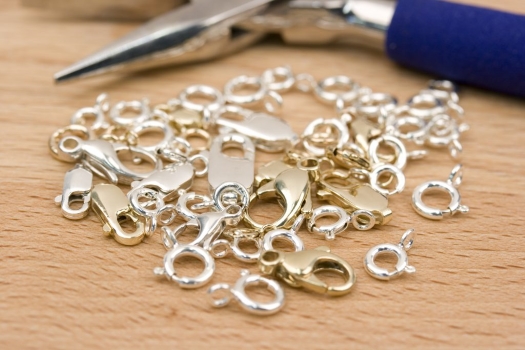When crafting or purchasing jewellery, the clasp is more than just a functional component, it’s a crucial element that ensures security, complements the design, and enhances the overall aesthetic. With a myriad of clasp types available, selecting the right one can elevate your piece from ordinary to extraordinary.
Bolt Ring Clasp
A classic choice, the bolt ring clasp features a spring-loaded mechanism that opens when a small lever is pushed and closes upon release.
Cons: Can be challenging for individuals with limited dexterity.
Best for: Lightweight necklaces and bracelets.
Pros: Secure and cost-effective.

You do need to be careful with them, however. Heat can ruin the lever mechanism. And the smaller sizes can be difficult to open and close for anyone affected by dexterity issues. Sizes range from 5mm to 22mm – which is much heavier and typically used for decoration only.
Shop our range of bolt ring clasps today.
Lobster Clasp
Resembling a lobster’s claw, this clasp is known for its durability and strength, making it a popular choice for various jewellery pieces.
Cons: Slightly heavier and more expensive than bolt rings.
Best for: Medium to heavy necklaces and bracelets.
Pros: Highly secure and reliable.

The durability means they’re often used with expensive pieces, or where there’s a heavier pendant or a longer chain. Effectively the weight of the chain offsets the weight of the clasp. They’re not suitable for lightweight jewellery chains or bigger jump rings – which can restrict functionality. Sizes range from 7mm to 18mm.
Shop our range of lobster clasps today
Trigger Clasp
Similar to the lobster clasp but often more rounded, the trigger clasp offers a generous opening, facilitating easier attachment.
Cons: Can be bulkier, affecting the design’s delicacy.
Best for: Heavier chains and pendants.
Pros: Enhanced functionality with larger jump rings.

They can be quite heavy, which makes them more expensive, but also a better choice for heavier weight chains and pendants – to provide balance. Sizes for trigger clasps range from 7mm to 18mm.
Shop our range of trigger ring clasps today.
Magnetic Clasp
Utilising concealed magnets, these clasps snap together effortlessly, offering convenience and ease of use.
Cons: Less secure for heavier jewellery; magnets may weaken over time.
Best for: Individuals with dexterity challenges; lightweight to medium-weight pieces.
Pros: User-friendly and quick to fasten.

They’re not the cheapest or lightest option around – hence why you’ll often see them used to attach beautiful strings of beads or pearls in expensive pieces. The weight and size of your necklace or bracelet is so important with magnetic clasps, so, if possible choose in person to avoid any costly mistakes.
Shop our range of magnetic ring clasps today.
Sliding Clasp
Featuring a silicone insert, the sliding clasp allows for adjustable sizing, making it ideal for versatile designs.
Cons: Requires bulkier chains for optimal grip.
Best for: Casual beaded bracelets and necklaces.
Pros: Adjustable and easy to use.
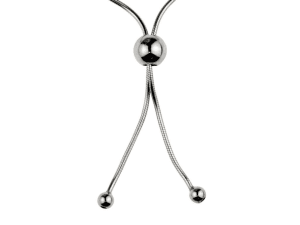
They’re commonly used on casual beaded bracelets and necklets, as they allow the size to be easily adjusted. To work well, sliding clasps do require a bulkier chain with a substantial end – so the silicone can grip the surface as the chain passes through the clasp. Snake, box or bead chain all work effectively.
Shop our range of sliding clasps today.
Albert Swivel Clasp
Named after Prince Albert, this clasp was traditionally used for pocket watches, allowing for full manoeuvrability without tangling.
Cons: Some versions may not swivel as intended.
Best for: Keyrings, bag charms, and vintage-inspired designs.
Pros: Provides 360-degree rotation; adds a vintage touch.
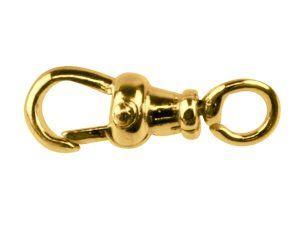
They’re most commonly used alongside objects that require full manoeuvrability, like key rings and bag charms. Be careful though – many ‘swivel clasps’ are sold with a fixed top, so don’t actually swivel at all. Sizes range from 13mm to 29mm.
Shop our range of Albert swivel clasps today.
Hook and Ring / T-Bar and Ring Clasp
These clasps rely on the weight of the jewellery to stay fastened, with the hook or T-bar fitting into a ring component.
Cons: Less secure for lightweight pieces.
Best for: Heavier necklaces and bracelets.
Pros: Adds a decorative element; easy to fasten.
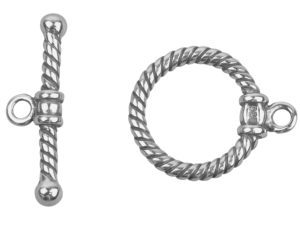
T bar and ring clasps come in many different styles. You just need to ensure there’s enough of an overlap of the ring, and that the necklace or bracelet is heavy enough to pull the clasp secure. Hook and ring clasps are better suited for lighter pieces with a more delicate fitting.
Shop our range of hook and ring and T bar and ring clasps today.
Padlock Clasp
Often used as a focal point, the padlock clasp adds both security and aesthetic appeal to jewellery designs.
Cons: Heavier and may require a safety chain for added security.
Best for: Heavyweight curb chain bracelets.
Pros: Secure and visually striking.
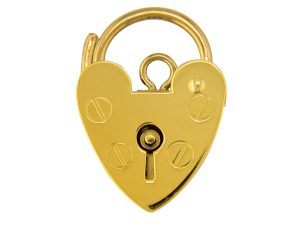
Once opened, both ends of your necklace or bracelet can be looped over the bar and snapped shut. You’ll often see padlock clasps paired with a short safety chain, attached to both ends of the piece and threaded through a loop at the top of the design. So, if the clasp were to open, your jewellery piece would remain attached.
Naturally, with such an elaborate aesthetic, they’re usually a focal point on a piece of jewellery. They’re also quite heavy, so it’s important to pair them with a heavy gauge chain – such as a heavyweight curb chain.
Shop our range of padlock clasps today.
Bayonet Clasp
Featuring a push-and-twist mechanism, the bayonet clasp offers a sleek and modern closure option.
Cons: May be challenging to operate for some users.
Best for: Contemporary jewellery designs.
Pros: Streamlined appearance; secure fastening.
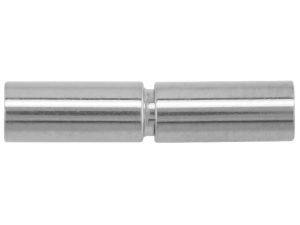
Loops can either be soldered to the end of each side or alternatively, lengths of rubber or leather can be glued into place as each piece of tube has been left unsealed. The bayonet clasp has lovely clean, uncomplicated lines so, it’s perfect for finishing contemporary, streamlined jewellery designs – without distracting from the main feature itself.
Shop our range of bayonet clasps today.
Multi-Strand Clasp
Designed to accommodate multiple strands, this clasp ensures that layered necklaces or bracelets stay aligned and secure.
Cons: Requires precise alignment during fastening.
Best for: Multi-strand jewellery pieces.
Pros: Keeps strands untangled; available in various styles.
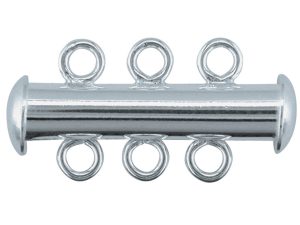
This type of jewellery clasp is very easy to use and provides a great way to fasten and secure multiple strand necklaces or bracelets. When using a multi-strand clasp, you just need to consider the width of your design – spacing on the clasps can vary.
For example, larger designs might require a bigger gap between the loops on your chosen clasp so that the separate strands lay flat.
Shop our range of multi-strand clasps today.
Discover Cooksongold’s full range of jewellery findings
Now you know more about the different jewellery clasp types, why not discover the vast range of other types of jewellery findings we stock here, at Cooksongold? Want to learn more about findings? Check out our Essential Guide to Jewellery Findings, which details everything from jump rings to collets to cufflink backs.
Find fine jewellery clasps at Cooksongold
Now you know more about the more basic styles and types of clasp, why not read part 2 and part 3 of this guide to learn more about other types of clasps? Or check out our Essential Guide to Jewellery Findings to discover the many other types of jewellery findings available.

Cooksongold

